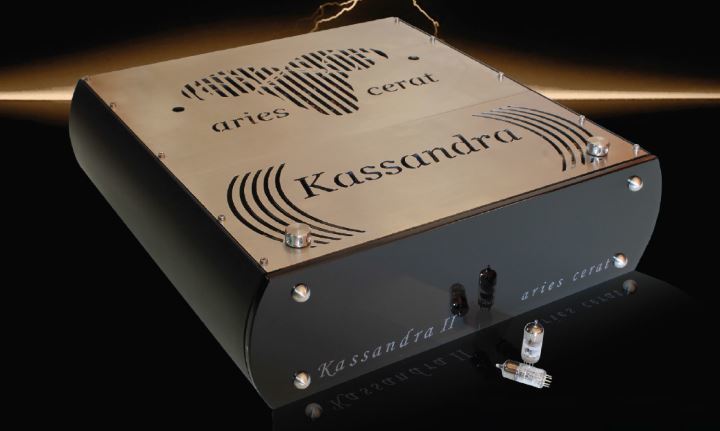“Since the advent of the CD, listeners have been deprived of the full experience of listening.” - Neil Young PonoPlayers...
Read More »
Aries Cerat Launches the New Kassandra II DAC

We believe that Kassandra dac is currently one of the best audio sources available today and can only be matched by top analogue sources in timpre and musicality, but keeping well ahead in aspects of dynamic presentation and resolution.
In the audio industry today, the market is in abandon of digital processors, with a new dac presented each week, in a race of finding the best converter. A race of numbers, with THD of -90db, oversampling @ radio frequencies and about 140db dynamic range. Yet, many audiophiles change dacs as soon as the next one arrives, without ever finding the one sounding “just” right. In the process of development of our reference system, we were also searching for the best available converter. Yet, no converter delivered the sound we expected, as a reference converter. Every dac presented an artificial feel in every recording, and almost all presented compressed dynamics and poor flow of music, easily noticed with un-compressed recordings and ultra high sensitivity horn systems. So, we began designing the best possible digital processor.
Delta sigma dacs are todays’ standard for digital processors. Not because they present better audio quality, but because of availability and ease of implementation of digital filters. Filters that became more and more complex, only because of the artifacts of delta sigma modulation.
R2R converters are only available in instrumentation converters because of their higher price. They are used for their supreme settling time and absence of glitch artifacts. We chose to use the AD1865, a 18bit R2R converter, probably the best sounding audio dac presented up to date and especially in the version we use, the AD1865N-K. We went a bit further and used 32 of them, 16 converters per channel.
Paralleling of converters improve the measurable parameters,as well as the sonic characteristics of the converter.The total SNR is improved by doubling of number of converters, linearity is also improved same as dynamic range and channel separation. Sonic wise, paralleling converters elevate performance in another level in all aspects significant in high end audio.Each doubling of the converters in parallel sets a new level of performance.
Dynamics and micro-details improve proportionally, so you can easily say that it is another converter altogether.
The 16 converters in each channel work in complimentary mode, so that 8 converters are inverted.The two differential converter banks work in perfect synchronicity and accuracy ,to achieve perfect symmetry.
The 16 converters are working in current mode,and use an I/V transformer so that the current differential is converted in single ended voltage output.No resistors or OPAMPS are used in the I/V conversion stage.
The analog stage is implemented by a single ended transformer coupled triode stage,using a super-tube, the E280F, working in triode mode, loaded with a step down output transformer. The tube’s grid is driven by the secondary of the I/V transformer via an adjustable bias supply. The tube power supply is an oversized choke regulated supply, making sure that the tube is up to the task of following the converter’s flashing dynamics. Furthermore, the step-down transformer reduces the output impedance to 40ohms, with a maximum swing @ full scale of 30Vpp sine wave.(10Vrms)
The converter is equipped with an internal super-clock, which re-clocks the converters, making the processor virtually immune to transport changes. The jitter is attenuated to < 5psrms , whatever the jitter level is present at the transformer coupled spdif inputs,or the USB asynchronous input. With the internal clock, there is no need for a word clock input. The super-clock re-clocker can be bypassed on the fly, so you can hear the effect of jitter elimination in your system.
Extensive use of 35 LC filters, implemented using RF chokes and high speed capacitors,to decouple all digital circuits,ICs etc from the power rails, as to eliminate PSU sources jitter.
The Kassandra Mk2 is available is signature version(to be launched),with upgraded power supplies. The Signature’s power supply is a complex system of a total of 8 torroidal transformers, for full separation of digital section, analog supplies, clock supply and the tube circuits. A total of > 2.5F of capacitance is present in the system, with more than adequate local de-coupling, high spec foil capacitors and gas rectifiers for the tube PSU.
*16 R2R converters per channel, complimentary current output
(using the top grade AD1865N-K , 8 converters per bank, 16 per channel)
* Eight ultra-low-noise regulators
(for the 4 converter banks)
*Extensive local decoupling, using tuned LC filters
*Over engineered power supplies, power input filters
(8 torroidal transformers,over 2.5Farad total system capacitance, wideband local decoupling, Sig version)
* Transformer I/V conversion
(custom wideband transformers, balanced current to SE voltage conversion)
* Internal Super-Clock
(bypass able on the fly.Separate torroidal transformer, triple regulated supply)
*Transformer loaded super tube output stage
(using the E280F tube. 5:1 step down transformer, double choke filtered supply)
- 30Vpp output @ 0db
- Balanced output(optional)
- USB input up to 24/384KHz
- Jitter attenuation down to femptosec level
- Output impendence ~40 ohms (balanced/se output)
Source: Press Release


